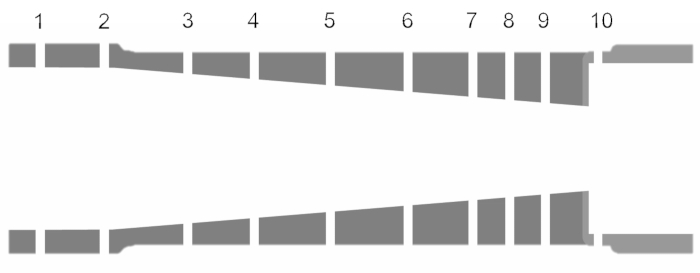노즐 분석: 수렴 및 수렴 전달 노즐에 따른 마하수 및 압력의 변화
Overview
출처: 슈레야스 나르시푸르, 기계 및 항공 우주 공학, 노스 캐롤라이나 주립 대학, 롤리, NC
노즐은 다양한 단면덕분에 흐름을 가속화하거나 감속하는 데 일반적으로 사용되는 장치입니다. 노즐은 항공 우주 추진 시스템에 널리 사용됩니다. 로켓에서 챔버에서 배출되는 추진제는 노즐을 통해 가속되어 시스템을 추진하는 반응력을 생성합니다. 제트 엔진에서 노즐은 고압 소스에서 기력을 생성하기 위해 배기의 운동 에너지로 에너지를 변환하는 데 사용됩니다. 노즐을 따라 이스엔트로픽 모델은 노즐의 흐름이 매우 빠르기 때문에 1차 분석에 충분하며(따라서 첫 근사치에 대한 방향분별)은 마찰이 거의 없기 때문에(충격파가 형성되고 노즐이 상대적으로 짧은 경우를 제외하고는 유동이 유리한 압력 그라데이션을 가진 거의 1차원이기 때문).
이 실험에서는 노즐 테스트 장비에 두 가지 유형의 노즐이 장착되어 압축 공기 소스를 사용하여 압력 흐름이 생성됩니다. 노즐은 다양한 유동 조건에서 노즐의 내부 흐름을 분석하고, 다양한 흐름 체제를 식별하고, 데이터를 이론적 예측과 비교하기 위해 다양한 역압 설정에 대해 실행됩니다.
Procedure
이 데모에서는 테스트 중인 노즐을 통해 고압 공기를 채널하는 압축 공기원으로 구성된 노즐 테스트 장비가 사용되었으며, 그림 5에나와 같이. 유압은 0- 120 psi범위이며 기계식 밸브를 사용하여 제어됩니다. 압력은 외부 센서를 사용하여 측정되지만 노즐의 질량 유량은 노즐 테스트 장비의 배기 직전에 배치된 한 쌍의 로타미터로 측정됩니다.

그림 5. 노즐 테스트 장비. 이 그림의 더 큰 버전을 보려면 여기를 클릭하십시오.
1. 수렴 및 수렴 발산 노즐에서 축 압 측정
Results
다음과 같은 상수는 분석에서 사용되었다 : 건조 공기의 특정 열, γ : 1.4; 참조 노즐 영역, A i = 0.0491 에서2,표준 대기압, Patm = 14.1 psi. 도 8과 9는 각각 수렴 및 수렴 분기 노즐에 대한 다양한 역압 설정에 대한 노즐 길이(총 노즐 길이에 따라 정규화)의 길이에 걸쳐 압력 비율 및 마하 수의 변동을 보여준다. 백압력 비율대 질량 유량 파라미터도 노즐 모두...
Application and Summary
노즐은 제한된 거리에서 흐름을 가속화하는 간단하고 효과적인 방법을 제공하기 때문에 항공기 및 로켓 추진 시스템에서 일반적으로 사용됩니다. 지정된 응용 프로그램에 맞게 노즐을 설계하기 위해서는 다양한 유동 조건에 대해 말한 동작에 영향을 미치는 흐름 동작 및 요인에 대한 이해는 효율적인 추진 시스템을 설계하는 데 필수적입니다. 이 데모에서는 항공 우주 응용 분야에서 사용되는 ?...
Tags
건너뛰기...
이 컬렉션의 비디오:

Now Playing
노즐 분석: 수렴 및 수렴 전달 노즐에 따른 마하수 및 압력의 변화
Aeronautical Engineering
38.0K Views

모형 항공기의 공기 역학적 성능: DC-6B
Aeronautical Engineering
8.3K Views

프로펠러 특성: 성능 관련 피치, 직경 및 블레이드 수의 변화
Aeronautical Engineering
26.5K Views

에어포일 동작: Clark Y-14 날개의 압력 분포
Aeronautical Engineering
21.2K Views

Clark Y-14 날개 성능: 고양력 장치 (플랩 및 슬랫) 적용
Aeronautical Engineering
13.4K Views

난류 구체 방식: 풍동 흐름 품질 평가
Aeronautical Engineering
8.7K Views

교차 원통형 흐름: 압력 분포 측정 및 항력 계수 추정
Aeronautical Engineering
16.2K Views

슐리렌 이미징: 초음속 흐름 특징을 시각화하는 기술
Aeronautical Engineering
11.7K Views

회류 수조 흐름 시각화: 델타 날개 위 첨단 소용돌이 관찰
Aeronautical Engineering
8.2K Views

표면 염료 흐름 시각화: 초음속 흐름 내 흐름맥 패턴을 관찰하는 정성적 방법
Aeronautical Engineering
4.9K Views

피트 정압관: 풍량 측정 장치
Aeronautical Engineering
49.2K Views

항온 풍속 측정: 난류 경계층 흐름 연구 도구
Aeronautical Engineering
7.3K Views

압력 변환기: 피트 정압관을 사용한 보정
Aeronautical Engineering
8.5K Views

실시간 비행 제어: 임베디드 센서 교정 및 데이터 수집
Aeronautical Engineering
10.3K Views

멀티콥터 공기역학: 헥사콥터 추력 특성화
Aeronautical Engineering
9.2K Views
Copyright © 2025 MyJoVE Corporation. 판권 소유

